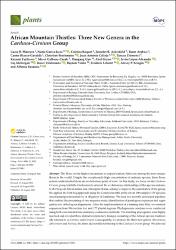| dc.contributor.author | Moreyra, Lucia D. | |
| dc.contributor.author | Garcia-Jacas, Nuria | |
| dc.contributor.author | Roquet, Cristina | |
| dc.contributor.author | Ackerfield, Jennifer R. | |
| dc.contributor.author | Arabacı, Turan | |
| dc.contributor.author | Blanco-Gavalda, Carme | |
| dc.contributor.author | Brochmann, Christian | |
| dc.contributor.author | Calleja, Juan Antonio | |
| dc.contributor.author | Dirmenci, Tuncay | |
| dc.date.accessioned | 2024-09-03T06:10:30Z | |
| dc.date.available | 2024-09-03T06:10:30Z | |
| dc.date.issued | 2023 | en_US |
| dc.identifier.issn | 2223-7747 | |
| dc.identifier.uri | https://doi.org/10.3390/plants12173083 | |
| dc.identifier.uri | https://hdl.handle.net/20.500.12462/15105 | |
| dc.description | Dirmenci, Tuncay (Balikesir Author) | en_US |
| dc.description.abstract | The floras on the highest mountains in tropical eastern Africa are among the most unique floras in the world. Despite the exceptionally high concentration of endemic species, these floras remain understudied from an evolutionary point of view. In this study, we focus on the Carduus-Cirsium group (subtribe Carduinae) to unravel the evolutionary relationships of the species endemic to the tropical Afromontane and Afroalpine floras, aiming to improve the systematics of the group. We applied the Hyb-Seq approach using the Compositae1061 probe set on 190 samples (159 species), encompassing representatives of all genera of Carduinae. We used two recently developed pipelines that enabled the processing of raw sequence reads, identification of paralogous sequences and segregation into orthologous alignments. After the implementation of a missing data filter, we retained sequences from 986 nuclear loci and 177 plastid regions. Phylogenomic analyses were conducted using both concatenated and summary-coalescence methods. The resulting phylogenies were highly resolved and revealed three distinct evolutionary lineages consisting of the African species traditionally referred to as Carduus and Cirsium. Consequently, we propose the three new genera Afrocarduus, Afrocirsium and Nuriaea; the latter did notably not belong to the Carduus-Cirsium group. We detected some incongruences between the phylogenies based on concatenation vs. coalescence and on nuclear vs. plastid datasets, likely attributable to incomplete lineage sorting and/or hybridization. | en_US |
| dc.description.sponsorship | Spanish Government PID2019-105583GB-C21
Catalan government PRE2020-093069
National Natural Science Foundation of China (NSFC) 2021SGR00315
Sino-Africa Joint Research Center 32270229
SAJC201614 | en_US |
| dc.language.iso | eng | en_US |
| dc.publisher | MDPI | en_US |
| dc.relation.isversionof | 10.3390/plants12173083 | en_US |
| dc.rights | info:eu-repo/semantics/openAccess | en_US |
| dc.rights | Attribution 3.0 United States | * |
| dc.rights.uri | http://creativecommons.org/licenses/by/3.0/us/ | * |
| dc.subject | Afroalpine | en_US |
| dc.subject | Afromontane | en_US |
| dc.subject | Carduinae | en_US |
| dc.subject | Carduus-Cirsium Group | en_US |
| dc.subject | Hyb-Seq | en_US |
| dc.subject | Systematics | en_US |
| dc.title | African mountain thistles: Three new genera in the carduus-cirsium group | en_US |
| dc.type | article | en_US |
| dc.relation.journal | Plants-Basel | en_US |
| dc.contributor.department | Necatibey Eğitim Fakültesi | en_US |
| dc.contributor.authorID | 0000-0003-4717-9063 | en_US |
| dc.contributor.authorID | 0000-0002-5108-2558 | en_US |
| dc.contributor.authorID | 0000-0002-4627-7318 | en_US |
| dc.contributor.authorID | 0000-0001-8748-3743 | en_US |
| dc.contributor.authorID | 0000-0002-6586-0939 | en_US |
| dc.contributor.authorID | 0000-0002-8906-7273 | en_US |
| dc.contributor.authorID | 0000-0003-3038-6904 | en_US |
| dc.identifier.volume | 12 | en_US |
| dc.identifier.issue | 17 | en_US |
| dc.identifier.startpage | 1 | en_US |
| dc.identifier.endpage | 22 | en_US |
| dc.relation.publicationcategory | Makale - Uluslararası Hakemli Dergi - Kurum Öğretim Elemanı | en_US |




















